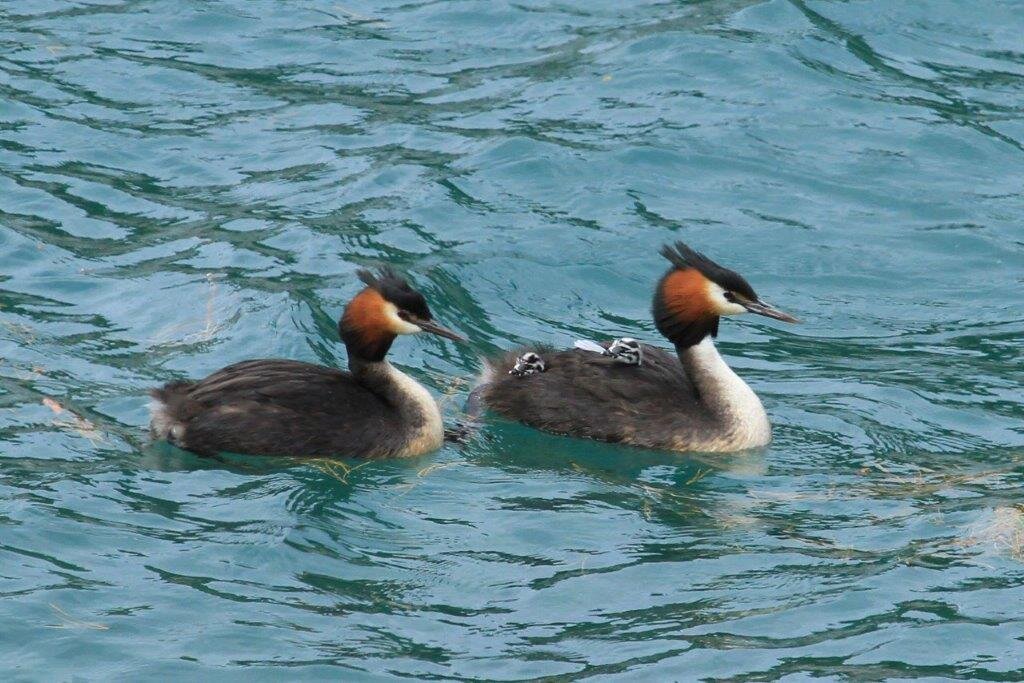
Grebes & Dotterels
pūteketeke & tūturiwhatu
The Guardians’ Committee actively protects and enhances the environment for the Grebe’s & Dotterels to call Lake Hāwea home.
Australasian Crested Grebe (pūteketeke, kāmana)
Photo: Ian Turnbull
Most of the community now knows about the Australasian Crested Grebe (Pūteketeke, Kāmana) that have been breeding this season beside ANZAC Peninsula.These charismatic birds have been real ambassadors for their species, since November 2020 when a pair was seen trying to nest in poor habitat near the Hāwea Dam. This nest site was doomed to fail, being exposed to changing lake levels, wind and predators. But grebes enthusiastically take up the offer of artificial floating nest platforms, as we have seen at the Wanaka Marina.
The Guardians borrowed a platform from the Lake Wanaka colony, put up information signs and placed predator traps nearby. The Grebe pair quickly built a nest, hatching 3 chicks in December, and then another, hatching a further 3 in February. The Guardians have built more platforms to support the Hāwea Grebe population with additional nesting sites next spring.
Banded Dotterel (tūturiwhatu, double banded plover)
Photo: Jan Solbak
The exposed gravel beaches around Lake Hāwea lack nesting habitat for this species, so it has been a great experience for the community to see and ‘adopt’ the Grebe family. We are grateful to John Darby for advice from his experience with the Wanaka Grebes, and to the community for their good behaviour around the nest site.
The Banded Dotterel (Tūturiwhatu or Double Banded Plover) is a lesser-known bird, but equally at risk. Both Dotterels and Grebes are classified as ‘Threatened - Nationally Vulnerable.’
Dotterels actually prefer exposed gravel beaches for breeding, and some nest at the delta of the Craig Burn, on the western shore of the lake. They breed in spring and summer, migrating to Australia for the winter months. The Guardians and other community members have been trying to put measures in place at the Craig Burn to protect these birds since 2019.
While talking with Land Information NZ (LINZ) about ways to manage ‘freedom camping’ here (mainly littering and toileting issues), we became aware that banded dotterels were nesting near the lake edge. These small birds are very vulnerable to introduced predators, vehicles, people and dogs. Their eggs and chicks are highly camouflaged for protection from predators such as hawks, so most people don’t even know the birds exist, and the nests are easily destroyed. Dotterels nest in pairs rather than in colonies, and here as in many parts of the country their preferred location is also used by people for recreation.
The Guardians worked with LINZ to put up signs about the risks to these birds, but these have not been heeded by many users, and we still see vehicles, people and dogs at the water's edge. A predator trapping line has removed more than 100 mice, over 70 rats, and 9 stoats/ferrets from the breeding environment. However, the best protection for the dotterels would be for people to avoid driving on the Craig Burn beaches and keep dogs on a leash in the breeding season (about October to February). For next breeding season, the Guardians will consult with LINZ on additional signage, and nests or nesting areas could be temporarily cordoned off.
Banded dotterels are under pressure around the country because of conflict with people and predators, and the Guardians are pleased to have a role in protecting these appealing little birds. We hope the community will help us.
Jane Forsyth
The Guardian’s Committee


